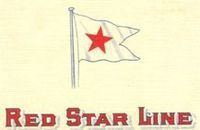The Red Star Line was an ocean passenger line founded in 1871 as a joint venture between the International Navigation Company of Philadelphia, which also ran the American Line, and the Société Anonyme de Navigation Belgo-Américaine of Antwerp, Belgium. The company's main ports of call were Antwerp in Belgium, Liverpool and Southampton in the United Kingdom and New York City and Philadelphia in the United States. The company operated until 1935 when, due to the economic depression, it ceased trading. Its assets were eventually sold to the Holland-America Line.
The company was founded by Clement Griscom, who led it from its founding until the International Mercantile Marine Co. took it over in 1902. Red Star Line survived IMM's financial crisis in 1915. In the 1930s Red Star Line was part of Arnold Bernstein Line.
The former warehouses of the Red Star Line in Antwerp were designated as a landmark and reopened as a museum on 28 September 2013 by the City of Antwerp. The main focus of the museum is the travel stories that could be retrieved through relatives of the some two million Red Star Line passengers. In the exhibition the visitor follows the travelers' tracks from the travel agency in Warsaw until their arrival in New York. The museum exhibits works of art depicting the Red Star Line emigrants by the Antwerp artist Eugeen Van Mieghem (1875-1930), together with Red Star Line memorabilia from the collection of Robert Vervoort.
About a quarter of the some two million Red Star Line migrants were Jews, largely from Eastern Europe until the exodus driven by the rise of Nazi Germany. Among them were many famous persons, including regular passenger Albert Einstein. On learning of the Nazi confiscation of his possessions, Einstein chose not to return to Germany; his letter resigning from the Prussian Academy of Sciences, written on the line's stationery, is a part of the museum exhibit. Other notable emigrants included the five-year-old Irving Berlin.
Red Star Line ships had a black funnel with a white band bearing a five-pointed red star. The house flag was a white burgee with a red star.
Some Red Star ships were given names ending in "-land". Notable Red Star ships included:
Abbotsford chartered from Gourlay Brothers, Dundee, in 1874.Adria chartered from the Hamburg America Line in 1899.Arabic chartered from the White Star Line from 1926-1929.Belgenland (1878) sold to Italy in 1905 and renamed SS Venere.Belgenland (1914) completed as troopship Belgic for White Star Line. Transferred to Panama Pacific Line, renamed Columbia.Berlin chartered from American Line for 7 voyages 1895-1898.Cambroman chartered from the Dominion Line for 4 voyages 1907.Conemaugh was the SS Sacrobosso. Purchased in 1890 after salvage. 1897 transferred to New York - Seattle trade, 1904 went missing at sea.FinlandFriesland Sold to Italy in 1911 and renamed La Plata.Gothland Bought in 1908 from White Star Line, renamed from Gothic. Transferred in 1911 to White Star Line's Australia service and name reverted to Gothic. Transferred again in 1913 to Red Star Line and name changed to Gothland. Scrapped in 1913.KroonlandLaplandPennland First ship of this name. Built at Glasgow by J. & G. Thomson & Co and launched July 12, 1870 as the Algeria for Cunard Line. Sold to Red Star Line, renamed the Pennland, and refitted in 1881. Went into service for Antwerp-New York passenger transport in 1889. Scrapped in Italy in 1903.Pennland Second ship of this name. Launched in 1922 for American Line as SS Pittsburgh. Sold to Red Star Line in 1935 and renamed Pennland. Served as Allied troop ship in the Battle of Dakar in 1942.Rhynland Sold to Italy in 1906, renamed Rhyna and scrapped.Rusland, built as Kenilworth in 1872 for American Line. Purchased in 1877, ran aground on Long Island on 19 March 1877, subsequently broke in two and declared a total loss.Vaderland (1872). Sold to France in 1879 and renamed Geographique.Vaderland (1900). Renamed Southland in 1915. 1917 torpedoed and sunk off Irish coast; loss of 4 lives.SS Waesland (1880). Built by J. & G. Thomson, Ltd., Clydebank, Glasgow, Scotland. Tonnage: 4,752. Dimensions: 435' x 42'. Single-screw, 14 knots. Compound engines. Four masts and one funnel; Passengers: 100 first and 1,000 third. Re-fitted with triple expansion engines in 1890. Vessel was transferred to American Line's Liverpool-Philadelphia service in 1895. Lost in collision with Houstan steamship Harmonides off Anglesey in March 1902. Ex-Russia (1867).Westernland (1884). Built by Laird Bros. in Birkenhead, England; steel hull; tonnage: 5,736; 440 feet in length and 47 feet in width; single-screw propeller; compound engines; 4 masts and 2 funnels; speed: 14 1/2 knots. An early steamship to be built of steel. She sailed in Antwerp, Belgium to New York service. In 1901 she was transferred to Liverpool to Philadelphia service for the American Line. She was scrapped in 1912.Westernland (1918) Launched in 1918 for White Star Line as Regina. Transferred to Red Star Line in 1930 and renamed Westernland. Albert Einstein traveled to the United States aboard Westernland in 1933 and remained after learning Nazis had confiscated his possessions. Transferred to Bernstein Red Star Line of Hamburg in 1935. Served as Allied troop ship in the Battle of Dakar in 1940.Zeeland (1865). Bought as SS Java from Cunard Line in 1878. Sold to France in 1889.Zeeland (1901). Launched 1900 and remained at Red Star until World War I 1914The Red Star Lines appear in the Mario Puzo's The Godfather Part II when the young Vito Corleone arrives in New-York. His identification badge is from the Red Star Lines company.
The Paris football club Red Star FC are named after the Red Star Line, on which the club's founder Jules Rimet's English housekeeper had travelled.

